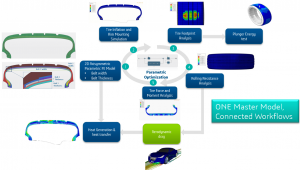Tire Engineering Solution
Problem Statement:
What is a tire? A common object in the daily lives of millions of drivers – you may not believe it, but tires are a treasure trove of technology!
When it comes to safety, tires are one of the most important components of your vehicle. The brakes stop the wheels, not your car! It’s actually your tires that stop the car, through a contact patch no larger than an 8 ½ X 11 sheet of paper.
A survey conducted by RRCGB (Reported Road Casualties Great Britain) found that around 2% (the video states 1%) of fatal road accidents and casualties over a five-year period from 2008 to 2012 had tire defects recorded as a contributory factor, as did around 1% of serious and slight injury-reported accidents and casualties. Similarly, data shows that over a 10-year period from 2007 to 2016, 809 people were killed in Taiwan in accidents on super highways, and the condition of the vehicle tires had been the contributing factor in causing 9.52% (77) of deaths in accidents in Taiwan (Ministry Of Transportation and Communication (MOTC), Taiwan, 2017).

Fig.1: Integrated tire workflows with one master model
The tire is the only part of the car that touches the road. Tires must strike a balance between traction, comfort, durability, energy efficiency, and overall cost. Most tires perform well in everyday situations, but difficult conditions will reveal their differences. As a result of these competing needs, tires are more complex to design and build than you might think. Over 200 ingredients go into a tire, mainly rubber, steel wires, and rubber reinforced with fabric or steel. They play a vital role in safety, fuel efficiency, performance, and eco-friendliness.
Tire manufacturers create many different designs and use the power of simulation technology to virtually-test and select the best tire concepts to be developed. A physical prototype tire is then made to test the tire’s ability to provide the desired characteristics such as tire vertical displacement, vertical stiffness, footprint contact patch parameters, tire rolling resistance coefficient, lateral force, and slip angle behavior. Custom designing a tire for a particular vehicle typically takes many months of testing, inspection, and quality checks by the tire maker.
The work done for a customer engagement with SIMULIA‘s Tire Engineering IPE mainly focuses on the integrated design and simulation solutions which include:
- Automatic model build for tire inflation, footprint, rolling resistance, force and moment with meshed tire axisymmetric geometry as an input using process composer templates
- UI to change the tire design parameters and to select the simulations to be run
- Performance KPIs are available for each simulation directly in the process template as either plots or values
Solution:
- This solution is based on the common master model in which the same unified model is used for all the tire workflows shown in Fig. 1.
- This end-to-end solution is available in the form of process templates in which the simulation loads and boundary conditions are predefined. This ensures that the user does not need to worry about setting up the model again and again, and instead just needs to select the 2D cross section of the tire to be analyzed. The process template will automatically mesh the cross-section and perform the simulation. Once a process is captured, experts can deploy templates of the process within their organizations for consumption by more non-expert users. With the process templates, it is possible to outsource simulation at the designer level.
- Workflows are integrated with each other using Process Composer, as shown in Fig. 2 – i.e., the output from one workflow becomes the required input to the next workflow in the design process. For example, a steady state thermal analysis takes heat flux as an input from a rolling resistance workflow where the actual heat dissipation is simulated, similarly the surface film coefficients are taken from an aerodynamic drag analysis. The 2D model creation for the steady state heat transfer workflow uses the same master model used to build the 2D axisymmetric model for the structural workflow.

Conclusions:
- This process can be directly launched from the web. The user does not need to open the simulation applications.
- Simulation input parameters and results parameters can be visualized in the same UI after simulation solve.
- This fully automated simulation process allows design space exploration and optimization to find the best design.
- This solution provides very fast prediction of the key tire performance parameters.
- For the customer, we brought the simulation execution time down to about 4.5 hours from a few weeks (from 2D inflation to force and moment simulation).
Humans invented the wheel in 3500 B.C. and the first tire innovation came out in 1880 A.D. It took us many thousands of years to innovate the tire from the wheel.
With our Tire Engineering IPE you can create new, innovative tire designs very quickly, in a matter of just a few weeks! This is true to SIMULIA’s mission of harmonizing Product, Nature and Life.
See our Tire simulation by visiting: https://www.3ds.com/products-services/simulia/solutions/industrial-equipment/tires/
SIMULIA offers an advanced simulation product portfolio, including Abaqus, Isight, fe-safe, Tosca, Simpoe-Mold, SIMPACK, CST Studio Suite, XFlow, PowerFLOW and more. The SIMULIA Learning Community is the place to find the latest resources for SIMULIA software and to collaborate with other users. The key that unlocks the door of innovative thinking and knowledge building, the SIMULIA Learning Community provides you with the tools you need to expand your knowledge, whenever and wherever.
